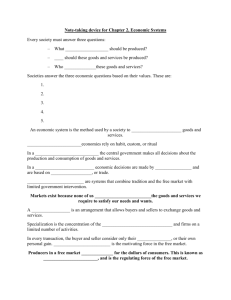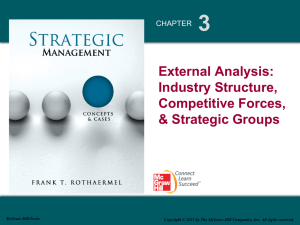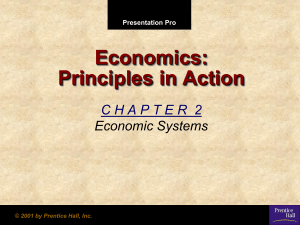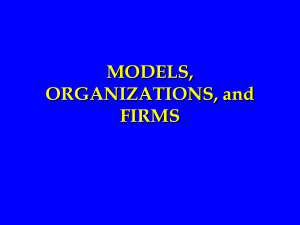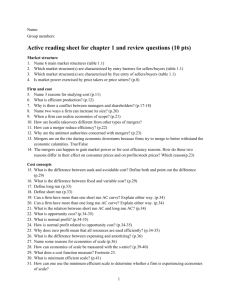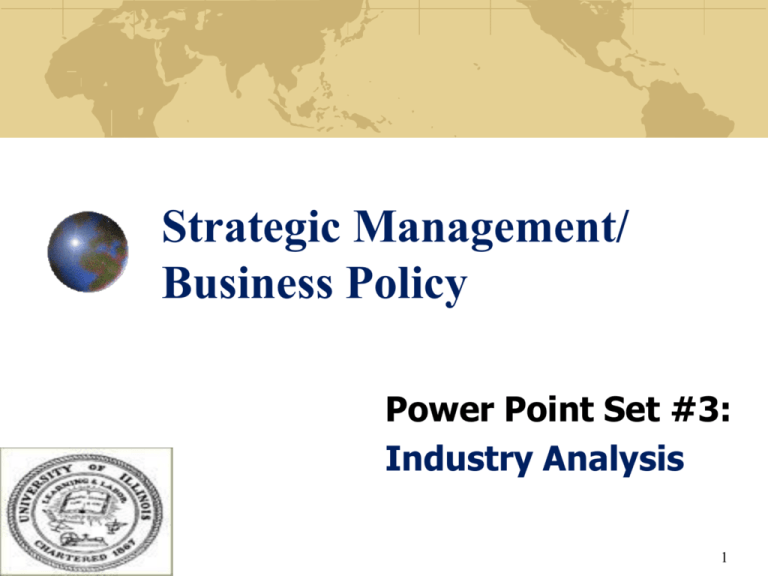
Strategic Management/
Business Policy
Power Point Set #3:
Industry Analysis
1
Efficient Markets
The efficient market hypothesis, which Professor Eugene
Fama of the University of Chicago has supported (e.g.,
in financial markets), is one in which prices reflect
information instantaneously and one in which extraordinary profit opportunities are thus rapidly dissipated
by the action of profit-seeking individuals in the market.
How well does the efficient market hypothesis for capital
markets apply to product markets?
If the efficient market hypothesis applied fully to product
markets then we should see over time equalization in riskadjusted rates of return across industries.
• What do the data support?
2
Differences in Profitability Across Industries
Average Return on Equity in US Industries, 1982-1993
16.5%
90
13.8%
11.7%
100
80
First Quartile
Average
22.2%
Fourth Quartile
Average
9.3%
70
60
Number
50
of
Industries
40
Average = 14.7%
Median = 13.8%
30
20
10
0
32%
30%
28%
26%
24%
22%
20%
18%
16%
14%
12%
10%
8%
6%
4%
2%
Return on Equity (Percent)
Note:
Source:
Return on Equity = Net Income / Year End Shareholders’ Equity; Analysis based on sample of 593 industries
Silverman 2000
© 2005 Mara Lederman, Rotman School of Management
3
Some Industries Are More Profitable Than Others
Differences in Profitability Across Selected Industries
Pharmaceuticals
Semiconductors
ROE & ROA - Selected Industries, 1989
Dental equipment
30%
Drug stores
25%
Race track operations
20%
Engineering services
ROE
ROA
15%
Cable television service
10%
Scheduled air transport
5%
-5
0
5
10
15
20
25
Operating income / assets, 1988-95 (%)
0%
Tires / Rubber
Source: Pankaj Ghemawat and Jan W.Pharmaceuticals
Rivkin, “Creating Competitive Advantage”
© 2005 Mara Lederman, Rotman School of Management
Home Appliances
4
Within Industries, Some Competitors Perform Better than Others.
Differences in Profitability Within Selected Industries
Semiconductor Industry
IntelROE - Pharmaceutical Industry 1989
60%Texas
50%
Instruments
Motorola
AMD
40%
Analog Devices
30%
National Semiconductor
20%
-5
0
5
10
15
20
25
Operating income / assets, 1988-95 (%)
10%
0%
Amgen
AMP
Eli Lilly
Merck
Source: Pankaj Ghemawat and Jan W. Rivkin, “Creating Competitive Advantage”
© 2005 Mara Lederman, Rotman School of Management
Mylan
Pfizer
5
6
Does
Does Industry
Industry Matter?
Matter?
Schmalensee
(1985)
Rumelt (1991)
McGahan &
Porter 1997)
Hawawini et al
(2003)
Percentage of variance in firms’ return on assets
explained by:
Industry
Firm-specific
Unexplained
effects
effects
variance
19.6%
0.6%
80.4%
4.0%
44.2%
44.8%
18.7%
31.7%
48.4%
8.1%
35.8%
52.0%
7
Decomposition of Variance in Profitability
Year
2%
Industry
18%
Corporate
parent
4%
Transient
46%
Business
segment
30%
Source: Anita M. McGahan and Michael E. Porter, “How Much Does Industry Matter Really?” Strategic Management Journal, 1997
© 2005 Mara Lederman, Rotman School of Management
8
Three Factors Determining Company Performance
Industry Context
e.g., during the last two decades, companies in the airlines industry
have been less profitable than those in the pharmaceutical industry
National Context
e.g., world’s most successful consumer electronics firms are in
Japan
Company Capabilities and Strategies
E.g., Wal-mart and Southwest Airlines
9
Industry Analysis Supports The Identification
of Threats and Opportunities
Strengths, Weaknesses, Opportunities, and Threats
- “SWOT” Analysis
Industry
Analysis
Strengths &
Weaknesses
Drivers
Opportunities
& Threats
Strategy
Internal
Factors
Values Of
Management
Objectives
External
Factors
Values Of
Stakeholders
10
Structure-Conduct-Performance
Industry Structure
• Number of buyers
and sellers
• Degree of product
differentiation
• Barriers to entry
• Cost structures
• Vertical integration
• Alliances
Firm Conduct
• Pricing
• Advertising
• R&D
• Investment in
plant and
equipment
Performance
• Econ profits
• Accounting
profits (ratios)
• NPV/DCF
• MVA/EVA
• Tobin’s Q
11
12
Structure-Conduct-Performance
Market Structure:
Number of buyers and sellers (e.g., CR4)
Barriers to entry
Substitutes
Cost Structures
Regulation
13
Structure-Conduct-Performance
Industry concentration is measured by the four-firm sales
concentration ration (CR4).
Problem: CR4 = .6 (.15, .15, .15, .15) or
CR4 = .6 (.57. .01, .01, .01)
– Which is more likely to exhibit monopoly power?
Alternative Measure: HHI index
7 firms (15, 15, 15, 15, 15, 15, 10) = 1450
44 firms (57, 1, 1, 1 …) = 3292 (3249 + 43)
Correlation between CR4 and HHI in 1982 was 0.954
14
Structure-Conduct-Performance
Defining the relevant market:
Even more important than choosing the proper index of
concentration is ensuring that the market for which
concentration is being measured is properly defined.
In the United States, the basic system is called the
Standard Industrial Classification (SIC). Onto it, the
Census Bureau has grafted an even more intricately
subdivided system organized around a series of seven
digit numbers, each successive digit reflecting a finer
degree of classification.
15
Structure-Conduct-Performance
In 1982, the manufacturing sector was divided into
450 such four-digit industries.
SIC Code
CR4
3632 household refrigerators
3511 turbines
2082 beer
3011 tires
2834 pharmaceuticals
3237 ready-mix concrete
.94
.84
.77
.66
.26
.06
# of firms
39
71
67
108
584
4161
HHI
2745
2602
2089
1591
1306
18
16
17
Barriers To Entry
The free entry and free exit assumption that works
reasonably well for describing financial markets
seems to be a premise that strays so far from our
world of experience that the assumption impedes our
understanding of real-world product competition.
• Thus, empirical evidence suggests
that(risk-adjusted) ROE does
NOT equalize in the long run.
18
A Taxonomy of Barriers to Entry
(1) Economies of Scale
Product-specific economies of scale
• Lower setup costs as a percentage of total costs
• More specialized machinery and tooling (e.g., Honda)
Plant-specific economies of scale
• Engineers’ 2/3 rule: Since the area of a sphere or cylinder varies as
two-thirds power of volume, the cost of constructing process industry
plants can be expected to rise as two thirds power of their output
capacity. (This rule applies to petroleum refining, cement making,
iron ore reduction and steel conversion).
• Also “economies of massed reserves”
19
20
Minimum Efficient Scale
• Minimum efficient scale (MES) is the point of
minimum average cost.
• It reveals the lowest output at which the firm
can operate at the lowest cost.
ATC(Q)
ATC(Q)
ATC(Q)
ATC(Q)
MES
Nile Hatch © 1996, 2000
Q
Q
MES
ATC(Q)
ATC(Q)
Q
Q
MES
Q
Q
21
A Taxonomy of Barriers to Entry
Economies of Scale
Multi-product economies of scale
(“economies of scope”)
• Example: Cost (Iron, Steel) < Cost (Iron) + Cost (Steel)
• Key idea: Shareable input (In this case, thermal
economies in the production of iron and steel)
• Modern examples: Aircraft, Automobiles, Consumer
electronics, Household Appliances; Personal Computers,
Software, Power Tools
Multi-plant economies of scale
• Economies of multi-plant production, investment, and
physical distribution.
22
Examples of Economies of Scope
Aircraft: Common wing, nose, and tail
components allow several models to be
leveraged using different numbers of
fuselage modules to create aircraft of
different lengths and passenger freight
capacities by Boeing and Airbus
Industries.
Automobiles: The Taurus platform is
leveraged to provide the basis for Taurus
and Mercury Sable sedans and wagons
and the Ford Windstar.
23
Examples of Economies of Scope
Consumer Electronics: Over 160
variations of the Sony Walkman were
leveraged by “mixing and matching”
modular components in a few basic system
designs. (“Legos”)
Personal Computers: Personal computers
typically consist largely of modular
components like hard drives, flat screen
displays, and memory chips, coupled with
some distinctive components like a microprocessor chip and enclosure.
24
Examples of Economies of Scope
Software
Software designers are creating
modules of routines which can be
combined to create customized
applications programs.
(The term “modularity” gained
wide currency by software
designers in the 1960s.)
25
A Taxonomy of Barriers To Entry
(2) Experience Curve Advantages
Marvin Lieberman, a management professor at
UCLA, found that in the chemical industry, on
average, each doubling of plant scale over time was
accomplished by an 11% reduction in unit costs.
Thus, there is an “89% learning curve.”
• (Note: The mere presence of an experience curve
does not insure an entry barrier. Another critical
prerequisite is that the experience be kept
proprietary, and not be made available to
competitors and potential entrants.)
26
Hours per unit, TN
120
100
80
60
40
20
0
TN = (100)(N log.90/log2)
0
100
200
Cumulative units, N
300
400
27
Aircraft Assembly (1925-57): 80%
Calculator (1975-78):
74%
© 1995 Corel Corp.
Heart Transplants (1985-88): 79%
© 1995 Corel Corp.
28
5-7
Production and Efficiency:
Learning Effects
Economies of Scale and Learning Effects
Unit Costs
.
A
Economies
of Scale
.
.
B
C
Learning
Effects
Average Costs
Average Costs
Output
29
Copyright 1998 by Houghton Mifflin Company. All rights reserved.
A Taxonomy of Barriers To Entry
Limits of “Learning Curve” Advantages:
Copying and reverse engineering of products;
Hiring a competitor’s employees;
Purchasing the know-how from consultants;
Obtaining the know-how from customers; and
Experience advantages are often nullified by innovations.
30
A Taxonomy of Barriers To Entry
(3) Intended Excess Capacity
Building extra capacity for the intended
purpose of deterring entrants from
entering the industry.
(Note: potential free-rider problems)
Excess capacity deters entry by increasing
the credibility of price cutting as an entry
response by incumbents.
• “Innocent” excess capacity:
Demand is cyclical; Demand falls short of
expectations; Demand is expected to grow.
31
A Taxonomy of Barriers To Entry
(4) Reputation
A history of incumbent firms reacting
aggressively to entrants may play a role in
current market interactions.
(5) Product Differentiation
Brand identification and customer loyalty to
incumbent products may be a barrier to
potential entrants (e.g. Coca-Cola). Product
differentiation appears to be an important entry
barrier in the market for over-the counter drugs
and in the brewing industry
32
A Taxonomy of Barriers To Entry
(6) Capital
Requirements
(7) High Switching Costs
of Buyers
E.g., changing may require
employee retraining
(e.g., IV solutions, and
computer software).
33
A Taxonomy of Barriers To Entry
(8) Access to Distribution Channels
The manufacturer of a new food product, for
example, must persuade the retailer to give it space
on the fiercely competitive supermarket shelf via
promises of promotion, and intense selling efforts
to retailers.
(9) Favorable Access to Raw Materials and to
Markets
• Alcoa --> bauxite
• Exclusive dealing arrangements
• Favorable geographic locations
34
A Taxonomy of Barriers To Entry
(10) Proprietary Technology
Product know how
Low cost product design
Patents (and other government restrictions)
(11) Exit barriers (of incumbents)
can be entry barriers (to potential
entrants)
35
A Taxonomy of Barriers To Entry
High exit costs:
High exogenous and endogenous sunk costs
(not just high fixed costs!)
High asset specificity
Highly illiquid assets
Low salvage value if exit occurs
High switching costs
Low mobility of assets
Credible commitments
Irreversible investment
e.g., Alaskan pipeline built in 1977 at a cost of $10 billion
36
Bargaining Power of Buyers
Buyers compete within the industry by forcing down
prices, bargaining for higher quality or more services, and
playing competitors against each other.
A buyer group is powerful when:
The buyer group is concentrated (potential collusion);
The buyer group purchases large volumes relative to
seller sales (e.g., HMO power buying drugs);
The product is standard and undifferentiated;
Few switching costs on the part of the buyer;
High switching costs on the part of the seller; and
Buyers pose a credible threat of backward integration
37
Threat From Substitutes
Substitute products increase the industry’s overall
elasticity of demand and limit the potential returns of
the industry by placing a ceiling on the prices that firms
in the industry can profitably charge.
Companies in the coffee industry compete indirectly
in the tea and soft-drink industries (all three
industries serve consumer needs for drinks).
38
Bargaining Power of Suppliers
Suppliers can be broadly defined as the supplier of any input:
Labor, Management, Technology, Physical Materials
The bargaining power of suppliers is high when:
It is dominated by a few companies and is more concentrated
than the industry it sells to;
It does not contend with substitute products;
The supplier’s product is an important input
to the buyer’s business; and
Supplier’s products are differentiated (high
switching
costs for the buyer).
39
Degree Of Rivalry Increases When:
Industry Concentration is lower;
Industry Growth is slower;
Product Differentiation is lower;
Over-capacity is higher; and
Exit Barriers are higher
Price competition is highly unstable. Price cuts are quickly and
easily matched by rivals, and once matched, they lower revenues
for all firms (unless price elasticity of demand is high enough).
40
Degree Of Rivalry
Advertising battles, on the
other hand, may well expand
or enhance the level of product
differentiation in the industry
for the benefit for all firms.
In other words, advertising is not
necessarily a “zero-sum” game.
41
The Uses of Industry Analysis
Static Analysis How Do We Explain Current Rivalry and Profitability?
Dynamic Analysis Where Is The Industry
In The Future?
Headed
42
Industries Evolve Over Time As The
Relationships Between The Five Forces Change
demand
Dynamic 5-Forces Analysis
time
43
44
A Sixth Force - The Presence of “Complementors”
Complementors
Industry participants whose businesses enhance
the value of yours
The opposite of Substitutes
The emergence of “Networks” of organizations
Examples
Computer manufacturers and software makers
Consumer electronics and entertainment companies
The Central Issue
How to get “complementors” to make strategic
investments, which mutually benefit both
companies?
45
A Sixth Force -The Presence of “Complementors”
The biggest benefit of considering
complementors is that they add a cooperative
dimension to Porter’s (1980) “competitive
forces” model.
“Thinking [about] complements is a different
way of thinking about business. It’s about
finding ways to make the pie bigger rather than
fighting with competitors over a fixed pie. To
benefit from this insight, think about how to
expand the pie by developing new complements
or making existing complements more
affordable.”
– Brandenburger & Nalebuff Co-opetition
46
Empirical Testing of Structure-Conduct (Strategy)- Performance
ROE(j) = 14.7 + .050 CR4(j) + .119 [CAP/S](j) +
(2.08)
(1.98)
1.30 [A/S](j) +1.40 [R&D/S](j) +0.26 [GROW](j)
(7.20)
(2.95)
(2.90)
t-statistics in parentheses
R-squared = .43
CR4 = 4-firm concentration
R&D/S = R&D/Sales
CAP/S = capital expenditures/Sales
ROE = return on equity
A/S = advertising/sales
GROW = demand growth
47
Empirical Testing of Structure-Conduct (Strategy)- Performance
Model Specification
In practice, researchers estimate a statistical
model of the following form where data are
aggregated to the industry level:
• Industry Profit Rates = f (Concentration, Barriers to
Entry, Demand …)
48
Empirical Testing of Structure-Conduct (Strategy)- Performance
Model Specification
Multiple regression analysis seeks to evaluate the
degrees to which deviations of the dependent variable
(and in this course our focus has been on profit rates
as the dependent variable) from its mean are
“explained by” or associated with variations in each
of a set of independent or explanatory variables
(e.g., concentration, barriers to entry, demand, etc.)
49
Empirical Testing of Structure-Conduct (Strategy)- Performance
Model Specification
The nature of this association is captured by regression
coefficients relating the profit rates in the industry of
each independent variable, allowing us to determine
the effect, for example, of a 10% increase in seller
concentration on profit rates, holding all other
explanatory variables constant (i.e., “ceteris paribus”)
50
Empirical Testing of Structure-Conduct (Strategy)- Performance
Model Specification
Structure-Conduct-Performance
Industry Structure
Predicted Sign
Reason
• Number of buyers
and sellers
• Degree of product
differentiation
• Barriers to entry
• Cost structures
• Vertical integration
• Alliances
CR4
+
CAP/S
+
A/S
+
Advertising intensity as a
product differentiation
barrier to entry
R&D/S
GROW
+
+
Technological know-how
Demand growth leads to
less likely price wars
Firm Conduct
• Pricing
• Advertising
• R&D
• Investment in
plant and
equipment
Performance
• Econ profits
• Accounting
profits (ratios)
• NPV/DCF
• MVA/EVA
• Tobin’s Q
Higher concentration
enables higher prices
Capital-cost barrier to entry
51
Empirical Testing of Structure-Conduct (Strategy)- Performance
Model Specification
Note that the multiple regression results are consistent with
(but do not prove!) the structure-conduct-performance model.
As you probably are aware from your statistics classes, there
are many potential problems that can interfere with the reliable
estimation of regression models, leading to incorrect inference
about the statistical significance and economic importance of
explanatory variables.
52
Empirical Testing of Structure-Conduct (Strategy)- Performance
Three Potential Problems:
(1)
Mis-specification problems;
(2)
Measurement problems; and
(3)
Identification problems
53
Empirical Testing of Structure-Conduct (Strategy)- Performance
(1) Mis-specification Problems:
Important Variables Omitted. In our regression, the
impact of substitute products, and the power of buyers and
suppliers have not been included in the model specification.
Irrelevant Variables Included. If you believe fervently
in “perfect capital markets” then you may question the
idea of capital cost entry barriers and therefore you
would question the inclusion of the independent
variable [CAP/S] in the model.
54
Empirical Testing of Structure-Conduct (Strategy)- Performance
(1) Mis-specification Problems:
Model assumes a linear relationship. Since the regression assumes
a linear relationship, this may turn out to be a poor approximation if
some of the explanatory variables (e.g., ADV/S) influence the
dependent variable (i.e., ROE) in a non-linear way.
Independent variable may not be truly independent.
For example, not only can increased concentration affect profit
rates but profit rates may affect industry concentration.
Multicollinearity. If independent variables such as
(ADV/S) and {R&D/S) are highly correlated, then the
validity of the t-statistics come into question.
55
Empirical Testing of Structure-Conduct (Strategy)- Performance
(2) Measurement Problems:
• For example, CR4 may not be the best measure of industry
concentration, where the HHI is a better measure. Perhaps
some performance measure other than ROE would also be
better for testing the theory.
Note: If the evidence is not consistent with the theory it is not
necessarily the case that we abandon the theory. One of the many
possibilities is that we do not have good measures of the theoretical
concepts.
56
Empirical Testing of Structure-Conduct (Strategy)- Performance
(3) Identification Problems:
- These problems are related to the idea that
“correlation does not imply causality.”
For example, you might maintain that high
advertising/sales is a barrier to entry (product
differentiation) strategy that causes high profit rates.
The regression is consistent with Porter’s (1980)
theory.
57
Empirical Testing of Structure-Conduct (Strategy)- Performance
(3) Identification Problems
However, you might argue instead that high profit rates
allow more discretionary spending in marketing and thus,
high profit rates cause high advertising/sales. The
empirical evidence is also consistent with this theory.
Thus, we have an “identification problem.” The data are
consistent with multiple theories and we must find more
refined tests and better econometric methods in order to
advance our scientific knowledge in strategic
management.
58

